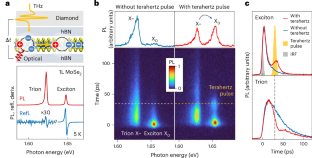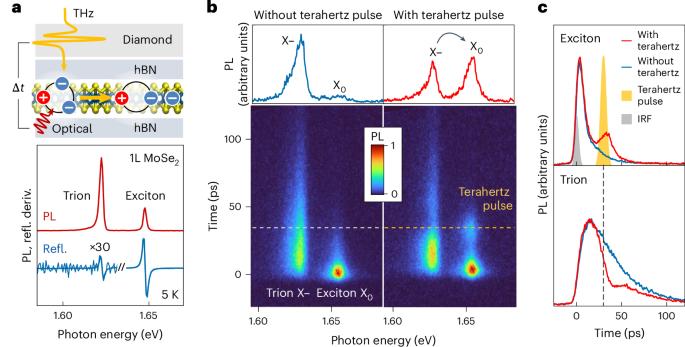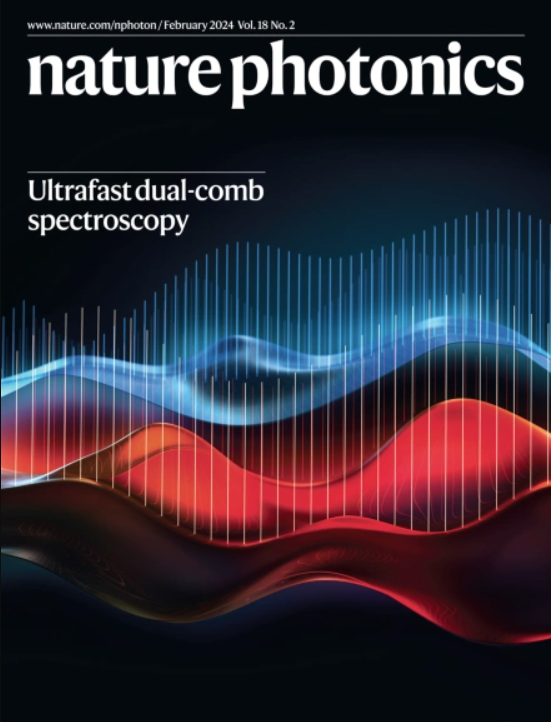太赫兹光子在二维材料中实现三离子的超快切换
IF 32.3
1区 物理与天体物理
Q1 OPTICS
引用次数: 0
摘要
光激发的外部控制是操纵光物质耦合的关键,也是光子技术非常需要的。在此背景下,单层半导体中的激子成为一种独特的纳米级平台,具有强大的光物质耦合、自旋谷锁定和优异的可调谐性。最重要的是,由于激子发射器与自由电荷载流子之间的高效相互作用,形成了被称为三离子和费米极子的新准粒子,因此它们可以实现光学响应的电开关。然而,这些态的光发射调整速度受到很大限制,使大多数应用基本上处于静态状态。在这里,我们展示了单层半导体中激子光发射器在超快皮秒时间尺度上的切换,方法是在光注入后,在太赫兹光谱范围内施加短脉冲。这一过程的基础是通过吸收太赫兹光子诱导光脱附将三离子快速转化为激子。通过监测光泵/太赫兹推动实验中的时间分辨发射动态,我们实现了所需的共振条件,并展示了该过程在延迟时间和太赫兹脉冲功率下的可调谐性。我们的成果为复合玻色-费米混合物发光激发的基础研究引入了一种多功能实验工具,并为基于原子薄材料的新型纳米光子器件的技术开发开辟了道路。本文章由计算机程序翻译,如有差异,请以英文原文为准。


Ultrafast switching of trions in 2D materials by terahertz photons
External control of optical excitations is key for manipulating light–matter coupling and is highly desirable for photonic technologies. Excitons in monolayer semiconductors emerged as a unique nanoscale platform in this context, offering strong light–matter coupling, spin–valley locking and exceptional tunability. Crucially, they allow electrical switching of their optical response due to efficient interactions of excitonic emitters with free charge carriers, forming new quasiparticles known as trions and Fermi polarons. However, there are major limitations to how fast the light emission of these states can be tuned, restricting the majority of applications to an essentially static regime. Here we demonstrate switching of excitonic light emitters in monolayer semiconductors on ultrafast picosecond time scales by applying short pulses in the terahertz spectral range following optical injection. The process is based on a rapid conversion of trions to excitons by absorption of terahertz photons inducing photodetachment. Monitoring time-resolved emission dynamics in optical-pump/terahertz-push experiments, we achieve the required resonance conditions as well as demonstrate tunability of the process with delay time and terahertz pulse power. Our results introduce a versatile experimental tool for fundamental research of light-emitting excitations of composite Bose–Fermi mixtures and open up pathways towards technological developments of new types of nanophotonic device based on atomically thin materials. Using short pulses in the terahertz spectral range following optical injection, ultrafast excitation of trions to excitons and free carriers in monolayer MoSe2 can be realized within picoseconds, advancing nanoscale optoelectronics devices.
求助全文
通过发布文献求助,成功后即可免费获取论文全文。
去求助
来源期刊

Nature Photonics
物理-光学
CiteScore
54.20
自引率
1.70%
发文量
158
审稿时长
12 months
期刊介绍:
Nature Photonics is a monthly journal dedicated to the scientific study and application of light, known as Photonics. It publishes top-quality, peer-reviewed research across all areas of light generation, manipulation, and detection.
The journal encompasses research into the fundamental properties of light and its interactions with matter, as well as the latest developments in optoelectronic devices and emerging photonics applications. Topics covered include lasers, LEDs, imaging, detectors, optoelectronic devices, quantum optics, biophotonics, optical data storage, spectroscopy, fiber optics, solar energy, displays, terahertz technology, nonlinear optics, plasmonics, nanophotonics, and X-rays.
In addition to research papers and review articles summarizing scientific findings in optoelectronics, Nature Photonics also features News and Views pieces and research highlights. It uniquely includes articles on the business aspects of the industry, such as technology commercialization and market analysis, offering a comprehensive perspective on the field.
 求助内容:
求助内容: 应助结果提醒方式:
应助结果提醒方式:


